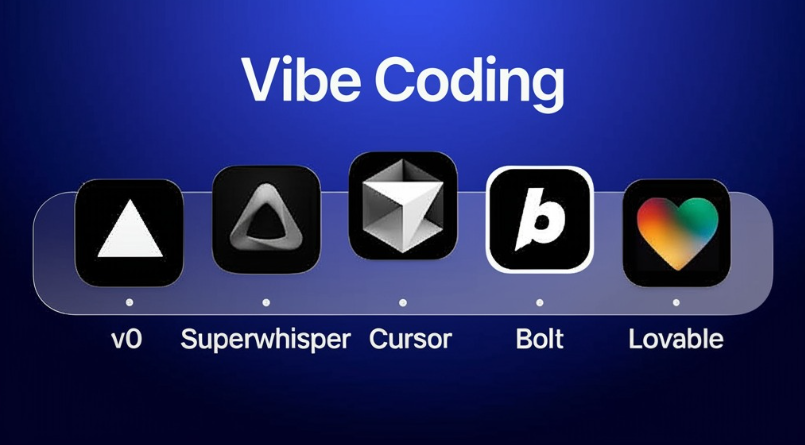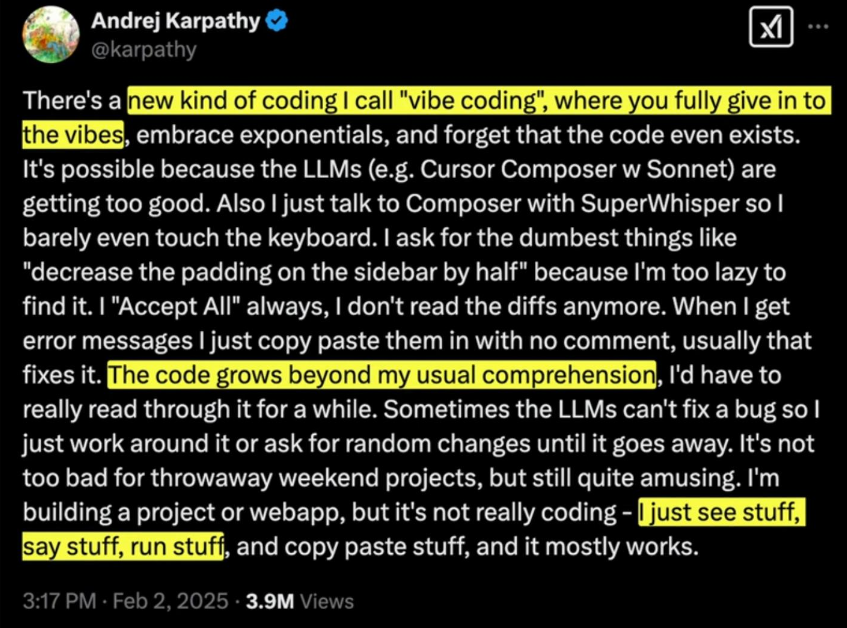The "Vibe Coding" Revolution: Redefining Software Development in 2025
 Patrick Alves
Patrick Alves
In the ever-evolving landscape of technology, a groundbreaking shift is reshaping how we approach software development. Welcome to the era of "vibe coding" – a paradigm that's not just changing how we write code, but fundamentally altering the role of developers in the tech ecosystem.
What is "Vibe Coding"?
Vibe coding is an emerging AI-dependent programming approach where developers describe problems in natural language and let AI tools generate the code. This technique allows programmers to create software quickly while focusing on high-level concepts rather than implementation details.
Coined by renowned computer scientist Andrej Karpathy on x.com, "vibe coding" represents a seismic shift in software development. His post went viral with almost 4 million views.

At its core, this approach allows developers to "completely surrender to the vibes," letting AI handle the heavy lifting of coding. But what does this mean in practice?
Natural Language Description: Developers express their intentions in simple, human language.
AI-Driven Code Generation: AI assistants transform these descriptions into functional code.
Rapid Iteration Cycle: Review, testing, and adjustments are made in collaboration with AI.
This method isn't just a minor tweak to our workflow; it's a complete reimagining of the development process. The Google Trends chart below showcases a dynamic shift in interest between "prompt engineering" (red line) and "vibe coding" (blue line) over time. Initially, "prompt engineering" maintained a steady level of popularity, consistently ahead of emerging trends. However, as we approach late February 2025, "vibe coding" experiences a remarkable surge in interest, quickly catching up and ultimately surpassing "prompt engineering" in popularity. This suggests a growing fascination with vibe coding, marking its transition from a niche concept to a mainstream topic within a short period.

Transformative Impacts
Democratization of Development
The barriers to entry in software development are crumbling. Non-programmers can now create prototypes and MVPs, opening up a world of innovation previously gatekept by technical expertise. This democratization is changing who can develop software and how ideas come to life in the digital realm.
Project Acceleration
In the fast-paced world of tech, speed is king. "Vibe coding" is delivering:
Development cycles up to 10 times faster
Rapid transition from idea to product
This acceleration isn't merely about acting quickly; it's about introducing innovations to the market at an unmatched pace, potentially transforming entire industries overnight.
Vibe coding represents a fundamental shift in programming methodology. Rather than writing code line-by-line, developers describe features in natural language and refine them through conversation with AI. Karpathy describes his process as simply "seeing things, saying things, running things, and copy-pasting things".
This new paradigm has gained significant traction rapidly. By March 2025, Y Combinator reported that 25% of startups in its Winter 2025 batch had codebases that were 95% AI-generated.
The Rise of Voice Programming
Within the "vibe coding" trend, voice programming is emerging as a game-changer. Tools like Cursor are enabling developers to speak their code into existence. This isn't just a productivity boost; it's making development more accessible to neurodivergent professionals and those with physical limitations, fostering a more inclusive tech community.
Top Vibe Coding Tools
The following table compares eight prominent vibe coding tools currently available.
| Tool | Key Features | Strengths | Best For |
| Cursor | AI-powered code editor with chat, edit, and agent modes; voice input support via SuperWhisper; flexible model selection (OpenAI, Grok, Claude) | Understands codebase context; can make project-wide changes; functions like having a tireless pair programmer | Developers who want a traditional IDE experience enhanced with AI capabilities |
| GitHub Copilot | Code completion; function generation from comments; evolving chat mode (Copilot X) | Widely adopted (1.3M+ users by early 2024); seamlessly integrates with popular IDEs | Developers already using VS Code or JetBrains IDEs |
| Replit Agent | Online IDE with AI that generates front-end, and back-end code and configures databases; mobile app creation through text/voice commands | Fully hosted environment for instant building and deployment; supports numerous programming languages | Quick prototyping; developers with limited technical experience; sharing working demos instantly |
| ChatGPT | Conversational AI that generates code snippets and complete programs; explains and debugs code | Versatile assistant for coding problems; newer versions can run code through Code Interpreter; excellent for explaining concepts | Brainstorming; troubleshooting; generating boilerplate code; learning programming concepts |
| Claude | Large context window for processing extensive code; recently released Claude Code terminal interface | Can consider more conversation/code history at once; particularly effective through Cursor integration | Complex projects requiring significant conversational context; detailed code explanations |
| Windsurf | Real-time collaborative coding environment with AI assistance; integrates version control and deployment | Optimized for team collaboration; suggests code improvements while maintaining project coherence | Development teams working on shared codebases; projects requiring tight integration between human developers |
| Bolt | Specialized in rapid application development with predefined templates and AI customization | Extremely fast prototyping; built-in component library; one-click deployment options | Startups and indie developers need to quickly validate ideas; creating MVPs with modern tech stacks |
| Lovable | User-centric design approach with AI-guided UX/UI generation; focus on end-user experience | Prioritizes usability and aesthetic appeal; bridges the gap between design and implementation | Frontend-heavy projects; applications where user experience is critical; design-focused developers |
Choosing the Right Vibe Coding Tool
The optimal vibe coding tool depends largely on your specific needs and technical background. For developers with coding experience who want to maintain IDE familiarity while leveraging AI, Cursor, and Windsurf offer an excellent balance. They provide comprehensive context awareness and extensive model selection flexibility. After careful consideration, I choose Windsurf as my main tool due to its intuitive interface, powerful Cascade feature, and seamless integration of AI capabilities into the development workflow.
For those already embedded in the GitHub ecosystem or using VS Code, Github Copilot provides a natural extension with its growing capabilities. Having evolved from simple code completion to more conversational interactions, it's becoming increasingly capable of vibe coding workflows.
Replit stands out for those seeking an end-to-end solution where code can be instantly deployed after generation. Its cloud-based approach removes many technical barriers, making it particularly suitable for beginners or those focusing on quick prototypes.
The newer entrants each target specific niches. Windsurf is my favorite one and excels in collaborative environments where multiple developers need to work together seamlessly. Bolt prioritizes speed of development with its template-driven approach, making it ideal for rapid prototyping. Lovable distinguishes itself with a focus on user experience, helping developers create aesthetically pleasing and intuitive interfaces without deep design expertise.
Essential Skills for Future Developers
As we dive deeper into the "vibe coding" revolution, it's crucial to understand the skills that will set apart the next generation of developers. This paradigm shift demands a unique blend of abilities that go beyond traditional programming, aligning with the emerging demands of collaborating with AI systems.
"Vibe coding" is redefining what it means to be a developer:
From Code Writers to System Architects
AI Collaborators and Requirement Interpreters
Focused on High-Level Design and Complex Problem Solving
Clear and Effective Communication
In the world of vibe coding, the ability to articulate requirements, intentions, and objectives precisely is paramount. Developers must master the art of crafting clear prompts for AI tools, ensuring that natural language models can process instructions effectively. This skill extends to voice-to-code programming, where verbal communication takes center stage.
Key Focus Areas:
Writing clear and structured prompts
Simulating dialogues with AI assistants
Articulating thoughts objectively for voice programming
Prompt Engineering
As AI-generated code becomes more prevalent, prompt engineering emerges as a critical skill. Developers need to design and refine prompts that yield precise, requirement-meeting code. This involves understanding problem contexts, experimenting with different request styles, and quickly identifying flaws in generated results.
Best Practices:
Specifying data types and desired output formats
Providing clear context and parameters
Iterative refinement of prompts for optimal results
AI Literacy
To collaborate effectively with advanced AI systems, developers must understand the fundamentals of how these models work. This knowledge base supports informed decision-making and problem-solving when using vibe coding tools.
Essential Knowledge:
Basic understanding of machine learning and NLP
Awareness of AI limitations and potential biases
Ability to mitigate risks in AI-generated code
Systems Design and Architecture
Vibe coding shifts the developer's role from writing individual lines of code to overseeing and integrating complex systems. Strong skills in systems design and architecture are crucial for creating scalable, secure, and maintainable applications.
Key Skills:
Data modeling
API design
Understanding of architectural patterns (e.g., microservices)
Automated Testing and Evaluation
While Vibe coding tools can generate functional code, ensuring reliability and security requires advanced testing skills. Developers must be proficient in creating automated tests and using AI-integrated tools for code review and vulnerability detection.
Focus Areas:
Unit testing and integration testing
Continuous validation techniques
AI-assisted code review
Critical Thinking and Creativity
The rise of vibe coding amplifies the need for strong analytical and creative skills. Developers must critically evaluate AI performance and explore innovative solutions that may not be immediately apparent.
Key Abilities:
Design thinking
Predicting technical and conceptual challenges
Creating intuitive, user-oriented software solutions
Ethics and Responsible Development
As AI takes a more prominent role in code generation, developers must be aware of the ethical implications. This includes considerations of privacy, data security, and social impact.
Important Aspects:
Understanding data regulations and legal compliance
Practicing responsible development
Considering the societal impact of AI-generated code
Adaptability and Continuous Learning
The rapidly evolving landscape of vibe coding demands a mindset of continuous learning and adaptability. Developers must be ready to master new tools, methodologies, and frameworks as they emerge.
Key Traits:
Flexibility in adopting new technologies
Proactive approach to learning
Ability to quickly absorb and apply new knowledge
By focusing on these skills – from communication and prompt engineering to AI literacy and ethical considerations – the new generation of developers will be well-equipped to lead in the era of vibe coding. As this methodology continues to reshape the development landscape, those who master these abilities will find themselves at the forefront of innovation, driving the future of software creation.
Challenges and Considerations
As with any revolutionary technology, "vibe coding" brings its own set of challenges:
Quality and Security: How do we ensure the excellence and safety of AI-generated code?
Deep Understanding: Are we at risk of losing fundamental programming knowledge?
Skill Evolution: What new competencies will developers need to cultivate?
These questions aren't just academic; they're crucial for the future of our industry. As described in the previous section, vibe coding doesn't replace the need for experienced engineers. As applications grow in complexity, the expertise of seasoned developers becomes invaluable. Their ability to architect solutions, implement design patterns, and optimize performance remains crucial. Vibe coding complements these skills, allowing for rapid prototyping and ideation while still leaving room for deeper technical refinement.
The Future of the Industry
As we look ahead, several trends are emerging:
New Tools: The rise of AI-native platforms designed specifically for "vibe coding" workflows.
Business Models: Adaptation to faster, more flexible development cycles.
Education: Overhaul of computer science curricula and coding bootcamps.
These changes aren't just affecting developers, they're reshaping the entire tech ecosystem.
Shaping Our Future
Vibe coding represents a paradigm shift in software development, offering a unique blend of creativity and functionality. It's not just a new tool, it's a new way of thinking about programming that feels more like painting a program than traditional coding. This approach allows developers and non-developers alike to bring their ideas to life faster than ever, focusing on the result and user experience rather than getting bogged down in technical details.
For those curious about vibe coding, I highly encourage you to give it a try. Whether you're a seasoned developer or someone entirely new to coding, this approach offers a fresh perspective on software creation. It democratizes the development process, giving more people the ability to turn their ideas into reality. As we move forward, vibe coding may well become the standard way we interact with computers to create software, opening up new possibilities for innovation and creativity in the tech world.
I have been applying vibe coding daily, achieving surprising results in productivity and innovation. In an upcoming blog post, I will share detailed insights and a practical tutorial of how I’ve been using it step by step.
The future of software development is here, and it's vibrating with possibility. Let's embrace it, shape it, and use it to create a more innovative, inclusive, and exciting tech landscape for all.
Subscribe to my newsletter
Read articles from Patrick Alves directly inside your inbox. Subscribe to the newsletter, and don't miss out.
Written by

Patrick Alves
Patrick Alves
I help companies to leverage Machine Learning to create innovative products through an end-to-end machine learning development process that designs, builds, and manages reproducible, testable, scalable, and evolvable ML-powered software with minimal cost.